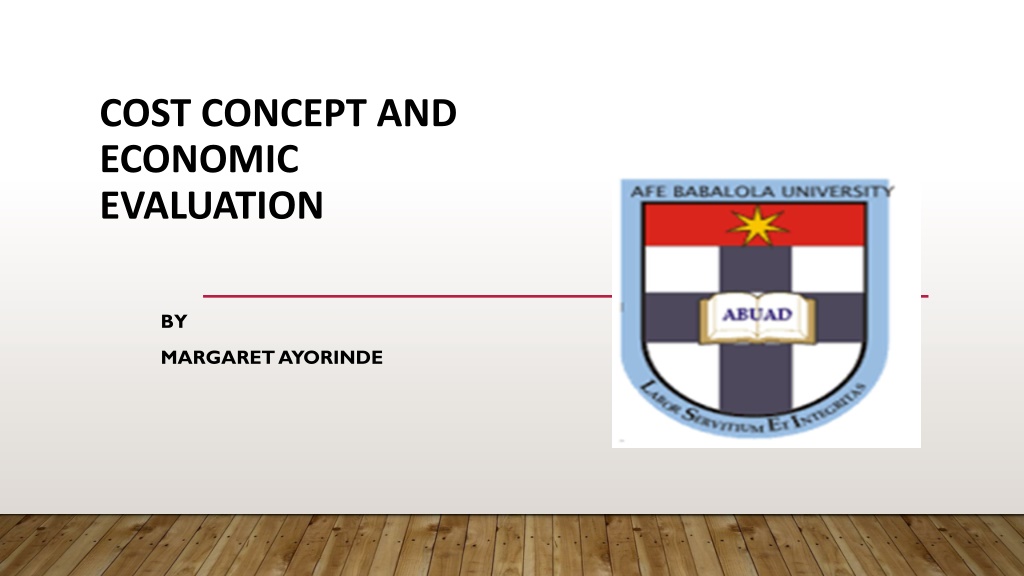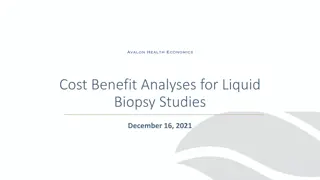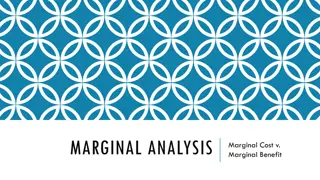Understanding Cost Concept and Economic Evaluation in Healthcare
This content delves into the definitions of cost, health care cost, and economic evaluation by Margaret Ayorinde. It presents learning outcomes, introduces health economic evaluations, and discusses the factors contributing to the rising costs in the healthcare market, emphasizing the essential role of economic evaluations in healthcare management.
Download Presentation

Please find below an Image/Link to download the presentation.
The content on the website is provided AS IS for your information and personal use only. It may not be sold, licensed, or shared on other websites without obtaining consent from the author. Download presentation by click this link. If you encounter any issues during the download, it is possible that the publisher has removed the file from their server.
E N D
Presentation Transcript
COST CONCEPT AND ECONOMIC EVALUATION BY MARGARET AYORINDE
LEARNING OUTCOMES Define cost and health care cost Understand the various types and elements of health care cost Understand the makes up cost of health care To be familiar with the reasons for the increasing cost of health care Know the peculiarities of the health care market
DEFINITIONS Cost is the monetary value of resources that are used for the production of products or services, based on a concept of opportunity cost. Health care cost is the actual costs of providing services related to the delivery of health care, including the costs of procedures, therapies, and medications. It is differentiated from HEALTH EXPENDITURES, which refers to the amount of money paid for the services, and from fees, which refers to the amount charged, regardless of cost. Economic evaluation can be defined as the comparative analysis of alternative courses of action in terms of their costs and consequences
INTRODUCTION Health economic evaluations take into account: costs involved with the provision of medical services/health care programs: pharmaceutical therapy prevention and control measures diagnostic methods screening methods any costs associated with the illness and/or health risks (or economic outcome) and how best to apply costing data.
INTRODUCTION CONT. Health economic evaluations are a essential tool in the health system management that: help improve efficiency and equity as well as informing decisions about equality and ethics. For instance, when calculating time costs, the same rate is used for all individuals regardless of gender, age, and income to avoid ethical violation.
INTRODUCTION CONT. Health care cost is high and has rapidly increased. Higher health care prices combined with an increase in the quantity of services provided has resulted in rising healthcare cost. The spending on health care involves prices and quantities and is often loosely referred to as healthcare costs. The production of health care requires scarce resources such as: capital in the form of hospital facilities diagnostic equipment the highly skilled labour of physicians, technicians, nurses and other paramedical staff
INTRODUCTION CONT. Health care market is peculiar since it has to do with human life. This is unlike other goods which if not affordable can be left unpurchased. The providers largely determine what the consumers need to pay for Not like other forms of market in which the consumer have enough information to determine exactly what he needs and to what extent the thing to be paid for will be beneficial.
The economic cost of a disease consists of direct and indirect cost. Direct cost is monetary expenditures attributable to the disease TYPES OF COST Indirect cost is what can be associated with loss of output attributable to the disease owing to premature death or disability. Direct medical cost Direct non-medical cost Indirect non-medical cost Intangible costs There are four types of health care cost:
Direct medical cost Medical cost incurred for medical products and services used to prevent, detect, and or treat a disease. These covers costs for drugs, laboratory tests and supplies. This cost has monetary value. Direct non-medical cost This type of cost cover non-medical services that results from illness but do not involve purchasing medical services. Example of this type of cost include cost of transportation, food, family care. This type of cost is usually enormous in developing countries where several relatives, friends come around to get involved in the care of patients.
Indirect non-medical cost This type of cost result from reduced productivity because of ill-health. When a patient is unable to do his usual job, the loss of productivity and income is at a cost. Intangible costs These are non-financial outcomes of disease and medical care not expressed in monetary value. The non-financial outcome can be in form of suffering, pain and grief. This cost can not be estimated in monetary value.
ELEMENTS OF COST These comprises of three elements: Loss of production. Expenditures for medical care. Pain, discomfort and suffering that accompany the disease.
VIEWPOINTS AND ECONOMIC EVALUATION A number of techniques have been described for full economic evaluation. Ideally, the evaluation should be linked with a clinical trial so that both costing and consequence data can be collected simultaneously. Consequence data is a lengthy and expensive process and evaluations often use existing medical literature in order to provide data on consequences. If this method is used, the data may not be accurate and certain assumptions may have to be made. Several analyses exist for full economic evaluation.
TYPES OF ECONOMIC EVALUATION Cost effective analysis Cost minimising analysis Cost utility analysis (CAU) Quality Adjusted life years analysis (QALY) Cost benefit analysis Cost of illness evaluation
COST EFFECTIVE ANALYSIS (CEA) Cost-Effective Analysis estimates the costs and health gains of alternative interventions. It provides a method for prioritizing the allocation of resources to environment and health interventions by identifying projects that have the potential to yield the greatest improvement in health for the least resources. CEA aims to determine possible interventions to achieves a given objective at the least cost.
COST EFFECTIVE ANALYSIS (CEA) CONT. Given a fixed budget, the intervention maximizes the effectiveness of the expenditure. The best cost-effective intervention is the one with the lowest total costs. In a situation where interventions are equal in cost, the better one is the one with highest effectiveness. The most cost-effective alternative is not always the least costly alternative for obtaining a specific treatment objective.
COST BENEFIT ANALYSIS Compares the cost incurred and the benefits obtained form the health care on the disease. When the benefits exceed costs, the resources have been effectively utilized. Cost benefit analysis compares the costs and benefits in using resources in a specific way as against alternative uses. Cost benefit analysis allows for the identification, measurement, and comparison of the benefits and costs of a programme or treatment alternative.
COST BENEFIT ANALYSIS CONT. The benefits realized from a programme or treatment alternative are compared with the costs of providing it. Both the cost and the benefits are measured and converted into the monetary equivalent in the year in which they will occur. Future costs and benefits are discounted or reduced to their current value. The costs and benefits are expressed as a ratio (a benefit : cost ratio).
COST BENEFIT ANALYSIS CONT. If the Benefit / Cost ratio is >1, then, the program or treatment is of value. Meaning that the treatment benefit outweigh the cost of providing the treatment. Where Benefit / Cost are =1, then, the benefits equal the cost. If Benefit / Cost is <1, then, the program or treatment is not economically beneficial. However, to measure in monetary terms, the benefit of an health intervention particularly in developing countries is difficult. This is a major limitation to using this type of economic evaluation.
COST OF ILLNESS EVALUATION This identifies and estimates the overall cost of a particular disease on a defined population. This method is often referred to as burden-of illness and it involves measuring the direct and indirect costs attributable to a specific disease. This method of evaluation does not really compare various strategies. Rather, it helps establish the cost of a particular disease on a defined population.
COST UTILITY ANALYSIS (CAU) It compares the cost or effectiveness of different options of using resources. Owing to the difficulty in measuring benefits (particularly humanitarian benefits), cost-effectiveness analysis is often used for economic appraisal in health care. CEA is a way of summarizing the health benefits and resources used by competing health care programs so that policy makers can choose among them.
COST UTILITY ANALYSIS (CAU) CONT. The outcome unlike the input is not measured in monetary unit. Cost-effectiveness-Analysis investigates the best and cheapest way of achieving a single objective by comparing effects and costs.
COSTS-MINIMIZATION ANALYSIS (CMA) This involves the determination of the least costly alternative when comparing two or more treatment alternatives. In CMA analysis, the alternatives must have an assumed equivalency in outcome. This method of evaluation is simple as it compares competing treatment modalities or programme as long as there is evidence that the outcomes of both modalities are equal.
QUALITY ADJUSTED LIFE YEARS ANALYSIS (QALY) A measure which tries to combine a quantitative measure (months gained, years gained etc) with a qualitative measure of the quality of that time. It allows more than one type of outcome to be included unlike CEA. This however assumes that there are no other objectives to health care than health maximization.
ELEMENTS OF COST Cost comprises 3 elements. Loss of production. Expenditures for medical care. Pain, discomfort and suffering that accompany the disease.























